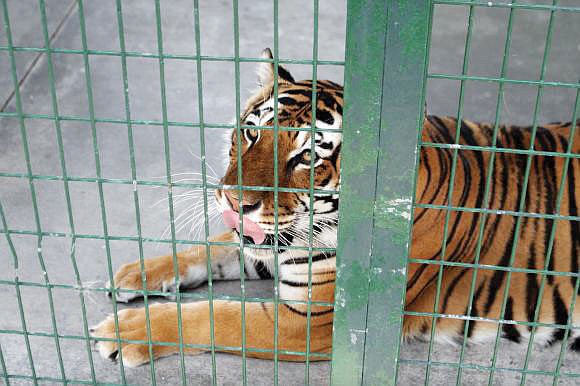- April 18, 2024
-
-
Loading

Loading

The only thing missing at the Big Cat Habitat is an ark — it has the animals and the flooding covered.
For more than three years, the popular Sarasota County tourist attraction has been trying to get the county to do something about an ongoing flooding problem that has affected its bottom line and poses a health threat to the animals.
“We’re becoming a wetland,” said Kay Rosaire, owner of the Big Cat Habitat. “We’ve lost grazing land for some animals, like the emus and the camels, and the mosquitoes that are breeding in the standing water are a concern for all the animals.”
Rosaire first brought the problem to the attention of the county in September 2010, after land-use changes in the area, such as construction of celery fields adjacent to the Big Cat Habitat grounds, began to affect rainwater drainage.
Rosaire said flooding at the popular tourist attraction worsened in the wake of county drainage-improvement projects meant to control stormwater runoff from the celery fields and other sites adjacent to the Big Cat Habitat property.
“It just isn’t draining,,” Rosaire said. “The water just piles up and breeds mosquitoes.”
Steve Cottrell, interim utilities director for Sarasota County, said the flooding at Big Cat is not the result of anything the county has done on adjacent properties.
“I don’t believe the county has, per se, done anything to cause flooding at the property,” Cottrell said. “The Big Cat Habitat historically has had low places that accumulate water and don’t drain well. They’ve been attempting to fix that. They still have work to do, and maybe they don’t have the funds to do it.”
The Big Cat Habitat houses a variety of big cats and other exotic animals. Rosaire said repairing flood damage to the animal enclosures has cost the habitat thousands of dollars. Rosaire added that the flooding has not prevented the park from staying open during the slow season, but closed-off parking areas from flooding will limit business in the tourist season.
“We can stay open right now, but we probably couldn’t in the peak of our season,” Rosaire said. “We need to fix this before then.”
One Sarasota County commissioner has taken an interest in the Big Habitat’s dilemma, and, according to Rosaire, has finally spurred the county to take action.
In a series of email exchanges last month, Sarasota County Commissioner Joe Barbetta expressed frustration with the county’s inaction on the issue, and said that unless the county steps in and fixes the drainage problem, a valuable Sarasota tourism destination could be in jeopardy.
“Here we are three years later with the problem still existing, and the county having done nothing,” Barbetta wrote in an email. “This is unacceptable.”
Cottrell admitted that county construction on the celery fields adjacent to the Big Cat Habitat “could have been done better,” but blamed the site’s topography and consistent rainfall this year for recent flooding. Cottrell said that analysis is now being done to determine how to lessen flooding in the most cost-effective way and without negatively impacting other properties.
“It’s a complicated site, to say the least,” Cottrell said. “We are intending to take whatever steps we need to, within our jurisdiction.”
Barbetta pushed for the county to take action.
“It appears to me there have been enough meetings and studies and hard data,” Barbetta wrote last month. “Let’s just get the corrective action completed.”
Rosaire said that the flooding problem was largely ignored until Barbetta pressed the issue.
“I think the county is working on a solution now, thanks to Mr. Barbetta,” Rosaire said. “No one was interested in helping us until he came by to take a look.”
According to county emails, former Sarasota County Surface Water Manager Warren Davis first addressed this issue in 2010, by proposing the installation of a relief pipe to allow faster drainage of the Big Cat Habitat.
The relief pipe was never built, and mobile stormwater pumps have been used as a temporary fix. According to an email from County Administrator Mark Cunningham, the pumps are insufficient, and a more permanent, sustainable solution is needed.